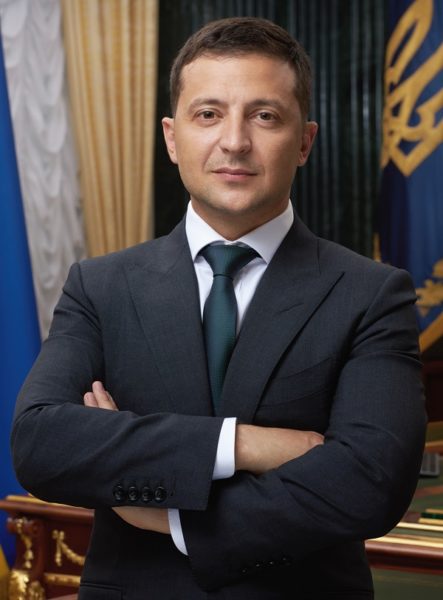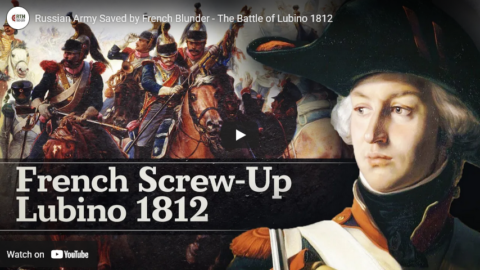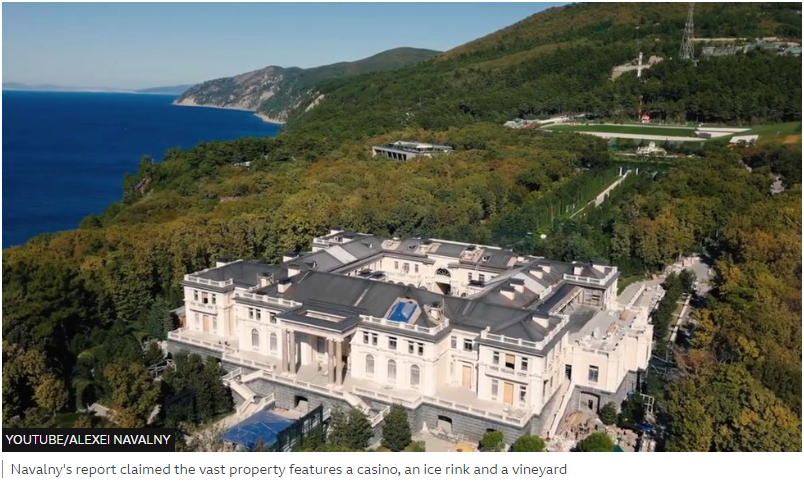Real Time History
Published 14 Apr 2022Support us on Patreon: https://patreon.com/realtimehistory
French general Junot and Emperor Napoleon I had a bit of a history by the time of the 1812 campaign. Even though Junot has been in Napoleon’s service for years, he hadn’t been promoted to Marshal. At the Battle of Lubino (Battle of Valutino-Gora) Junot stands idly by as the Grande Armée is missing their best chance yet to win a decisive victory over the Russians. To the north, at Polotsk the French and Russians are also clashing.
» THANK YOU TO OUR CO-PRODUCERS
John Ozment, James Darcangelo, Jacob Carter Landt, Thomas Brendan, Kurt Gillies, Scott Deederly, John Belland, Adam Smith, Taylor Allen, Rustem Sharipov, Christoph Wolf, Simen Røste, Marcus Bondura, Ramon Rijkhoek, Theodore Patrick Shannon, Philip Schoffman, Avi Woolf,» SOURCES
Boudon, Jacques-Olivier. Napoléon et la campagne de Russie en 1812. 2021.
Lieven, Dominic. Russia Against Napoleon. 2010.
Maag, Albert. De Schicksale der Schweizerregimente in Napoleons I. Feldzug nach Russland 1812. 1900.
Rey, Marie-Pierre. L’effroyable tragédie: une nouvelle histoire de la campagne de Russie. 2012.
Zamoyski, Adam. 1812: Napoleon’s Fatal March on Moscow. 2005.» OUR STORE
Website: https://realtimehistory.net»CREDITS
Presented by: Jesse Alexander
Written by: Jesse Alexander
Director: Toni Steller & Florian Wittig
Director of Photography: Toni Steller
Sound: Above Zero
Editing: Toni Steller
Motion Design: Toni Steller
Mixing, Mastering & Sound Design: http://above-zero.com
Digital Maps: Canadian Research and Mapping Association (CRMA)
Research by: Jesse Alexander
Fact checking: Florian WittigChannel Design: Simon Buckmaster
Contains licensed material by getty images
Maps: MapTiler/OpenStreetMap Contributors & GEOlayers3
All rights reserved – Real Time History GmbH 2022
April 15, 2022
Russian Army Saved by French Blunder – The Battle of Lubino 1812
Volodymyr Zelensky has become a “pop cultural admixture of Churchill and an ’80s action hero”
In The Line, Andrew Potter explains how Ukrainian President Zelensky has shamed all the western leaders — like Trudeau — who have been long on rhetoric and short on action to support their claimed values:

“Volodymyr Zelensky Official portrait” by http://www.president.gov.ua/ is licensed under CC BY 4.0
When asked by journalists to explain his refusal to head for safety, Zelensky has made it clear that he has no wish to die, and that he fears for the lives of his loved ones (his wife and kids have since been moved to relative safety.) But, he added: “As for my life: I am the president of the country, and I simply do not have the right to it.” Sure, he could flee to preserve his own life. But, he has said, how would he explain his actions to his kids? As Zelensky sees it, he has no choice in the matter. His duty requires that he remain and lead his country in the fight; to do anything less would be dishonourable.
But while his Last Action Hero schtick has proven enormously popular with European and North American audiences, Zelensky’s refusal to leave Kyiv, and Ukraine’s insistence on fighting off the Russians instead of capitulation, has put our so-called leaders in a bit of a bind.
To begin with, Ukraine’s refusal to capitulate to Russian aggression has forced many governments into taking steps they almost certainly would have preferred to avoid — economic and political sanctions against Russia, costly shipments of arms and other aid, diplomatic side-choosing, rethinking of trade agreements, and so on. Ukraine’s defence is coming at a pretty high cost, and the final bill is far from being tallied.
But beyond the economic and political price that is being paid to support Ukraine, there is the extraordinary amount of cognitive dissonance Zelensky’s behaviour has generated amongst the leadership of the West. Honour? Duty? Sacrifice? What century does he think he’s living in?
For centuries, honour reflected the sorts of qualities that gentlemen were expected to possess: dignity, integrity, courage. But it is hard to even talk about honour now with a straight face. It brings to mind 19th-century aristocrats in wigs and hose, demanding satisfaction and challenging one another to a meeting over some best-forgotten offence. The old honour codes couldn’t survive the triumph of the values of liberal democracy and the arrival of what Francis Fukuyama famously called the End of History, where the willingness to risk one’s life for abstract ideas or principles has been replaced by voting and economic calculation in the public sphere and “the satisfaction of sophisticated consumer demands” in the private.
Today, the old notion of honour survives only in small and isolated precincts of (mostly) male society, places like the military and some sports, places where how you behave in front of your peers matters more than comfort, more than money, more than health, maybe even more than life itself. The rest of us have become versions of what Nietszche derided as “the last man” — creatures of liberalism who have no pride, take no risks, and desire only comfort and security.
The West Sacrifices Poland to the Soviets – WAH 056 – April 1943, Pt.1
World War Two
Published 14 Apr 2022There are cracks in the alliances on both sides. Hitler’s allies are refusing to do his every bidding, and the revelations about the Soviet massacre of Poles in Katyn has set a wedge between Poland and the USSR.
(more…)
Vladimir Putin as real-life Bond villain
In The Critic, Peter Caddick-Adams makes a case for Vladimir Putin being all of Ian Fleming’s fictional 007 adversaries brought to life in a single person:
I am certain Vladimir Putin has a giant coloured globe, or maybe a huge map set in a wall, which at the tap of a button, silently slides in and out of view. In his mind, he will no doubt have experimented with his artist’s palette, of coating many of his geographical neighbours with his favourite shade of bright, bloody crimson.
Talking of sliding panels operated by secret switches, I would be surprised if the Russian leader has not watched all the James Bond movies, if only out of professional interest. He would see, if so, that he is every one of Ian Fleming’s villainous creations — Ernst Stavro Blofeld, Le Chiffre, Sir Hugo Drax, Auric Goldfinger, Emilio Largo, Dr Julius No and Francisco Scaramanga — all rolled into one person.
Presiding over the robber state that is the Russian Federation, Putin is at once militarily and politically all-powerful, but also the master international criminal. At a 2017 US Senate Judiciary Hearing, the Putin arch-critic and American financier, Bill Browder, estimated the Russian had “accumulated $200 billion of ill-gotten gains”, describing him as “one of the richest men in the world, if not the richest”.
It was the Second World War espionage boss, Commander Ian Fleming, who brought not only his world famous spy to life, but also the lairs of James Bond’s opponents. Fleming had inspected many of the Nazi underground factories and subterranean rocket bases immediately after the defeat of the Fatherland in 1945. In print, they appeared as his villains’ secret headquarters.
Fleming’s novels were in turn translated into celluloid by the talent of set designer Ken Adam. He worked on seven Bond movies, beginning with Dr No in 1962, via You Only Live Twice, and Diamonds Are Forever, and devised the circular War Room in Stanley Kubrick’s Dr Strangelove of 1964. If you don’t remember the scene, you’ll recall its most poignant line: “Please, gentlemen, you can’t fight in here. This is the War Room.”
Adam was also working with inside knowledge, for he was born in Berlin, to Jewish parents, who fled to Britain in 1934. On the outbreak of war, Adam enlisted into a British army engineering unit composed of Axis nationals, designing bomb shelters. He later joined the Royal Air Force as a fighter pilot, where he was known as “Heiney the Tank Buster”. After VE-Day, Adam toured the concrete structures and German bases he had attacked. “I flew fighters in the war, made some great movies and was Knighted by the Queen [in 2003]. Not bad for a Jewish lad from Berlin,” he told me in an interview.
In a bizarre case of real life imitating fiction, it was Alexei Navalny, now rotting in Russia’s harshest penal colony for his exposé, who discovered Putin’s covert lair. Sprawling on the Black Sea coast, it might have been designed by Ken Adam. The Russian leader’s $1.9 billion palace comes with a below-ground grand salon, hollowed-out of the cliff-face, lit by a gigantic panoramic window, that, at the touch of another button, can be retracted to let in the sea breezes. Access to the beach or the rest of the complex is by tunnels carved into the rock.
Its existence is naturally denied by the Kremlin, but the site, at Cape Idokopas, near the village of Praskoveevka, is equipped with two helipads, and reputedly 39 times the size of Monaco. I make the basic assumption that scores of designer-stubbled security muscle, dressed in black, toting sub-machine-guns, with a shoot-on-sight brief, will be prowling about.
Look at Life – Thunder in Waiting (1960)
PauliosVids
Published 20 Nov 2018The deadly cargo of the Vulcan Bomber is a crucial part of Britain’s deterrent force.
QotD: Men without hobbies shouldn’t ever retire
I took an older guy somewhere during my early-morning Uber shift, and we got to chatting about retirement. He was in his early sixties and was thinking about retirement in the next couple of years or so — he’d reached all the retirement “qualifications” in terms of his age, length of service, and so on — and when I asked him what he was going to do after retirement, he said quite simply, “I don’t know.” He had no outside interests other than his work, he said, and had no hobbies or anything to keep him occupied when he would quit working.
This set off all sorts of alarm bells in my head, because I’d confronted the very same thoughts when I planned on retiring back in 2016 on reaching age 62 (which seems to be the “killer” age discovered by the researchers).
Worse than that, I either know men personally or have heard of many instances of men who have died soon — very soon — after retiring early. (When men retire at a later age, they paradoxically seem to live longer, as the study shows.) Sometimes, men die within six months of getting their gold watch, after many decades of working with little or even no time off for illness. Where I differ from the study is that I think I know the real reason why this happens.
We’re working dogs.
As long as men have work to do, we do fine. We have a purpose in life, we get up in the mornings with a day’s work ahead of ourselves, and this gives us a reason to live. It’s all tied up, I believe, in our inherent nature as providers and all that goes with it. When that activity stops earlier than expected — at 62, most of us have at least fifteen or even twenty more years to live — subconsciously we still feel that we are capable of working, providing and in short contributing to ourselves and others.
But when that ends, it’s as though a switch is turned off somewhere and our brains simply say, “Oh well, that’s it,” and we die. It may be that illness has been kept at bay through our industry and now given an empty playing field, so to speak, it takes over; or it may be that we do things that are more dangerous (the study mentions driving more as one activity), or perhaps we working dogs just feel useless and our existence, pointless.
Kim du Toit, “Working Dogs”, Splendid Isolation, 2018-02-15.






